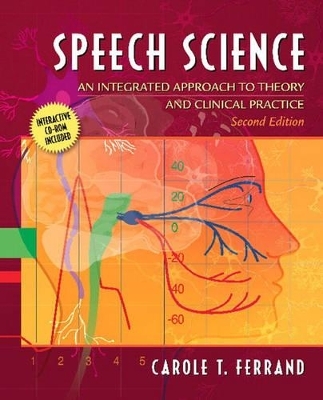
Speech Science
Pearson
978-0-205-48025-8 (ISBN)
- Titel erscheint in neuer Auflage
- Artikel merken
Each chapter presenting theoretical information is followed by a corresponding chapter on clinical application, demonstrating the connections between scientific theory and clinical management of communication disorders. To reinforce this link, case studies and questions in each clinical application chapter help students focus on how scientific principles are applied in clinical contexts.
Call-out notes, summary points, and review questions help students consolidate material for improved retention. Schematic illustrations enhance the text and demonstrate anatomical and functional relationships between structures. With this student- and instructor-friendly text, students will find theoretical information meaningful, less intimidating, and more easily accessible.
The Second Edition features two new chapters on neurology that present a comprehensive yet targeted discussion of neuroanatomy and neurophysiology relevant to speech production (Ch. 12) and examine current brain imaging techniques (Ch. 13). In each clinical application chapter, case studies and follow-up questions reinforce the link between science and clinical application. Pedagogical aides such as call-out notes in the margins have been included in all chapters to underscore important concepts. Plus, this edition comes packaged with a new DVD to accompany the text that provides visualizations of many important concepts, as well as self-test quizzes for students to evaluate their understanding of the material.
Each chapter concludes with "Clinical Case Study and Questions," “Summary” and “Review Exercises.”
Foreword.
Acknowledgments.
1. Introduction.
Overview of Chapters.
2. The Nature of Sound.
Air Pressure.
Measurement of Air Pressure
Movement of Air
Air Pressure, Volume, and Density
Sound: Changes in Air Pressure
Elasticity and Inertia
Wave Motion of Sound
Characteristics of Sound Waves
Frequency and Period
Velocity and Wavelength
Sound Absorption and Reflection
Constructive and Destructive Interference
Pure Tones and Complex Waves
Speech as a Stream of Complex Periodic and Aperiodic Waves
Visually Depicting Sound Waves: Waveforms and Spectra
Attributes of Sounds
Frequency and Pitch
Human Range of Hearing
Amplitude and Intensity
Amplitude
Intensity
Decibel Scale
Advantages of the Decibel Scale
Auditory Area
Resonance
Free and Forced Vibration
Types of Resonators
Acoustic Resonators
Acoustic Resonators as Filters
Bandwidth
Cutoff Frequencies
Resonance Curves
Parameters of a Filter
Types of Filters
3. Clinical Application of Frequency and Intensity Variables.
Vocal Frequency and Amplitude
Frequency Variables
Average Fundamental Frequency
Frequency Variability
Maximum Phonational Frequency Range
Amplitude and Intensity Variables
Average Amplitude Level
Amplitude Variability
Dynamic Range
Voice Range Profile
Breakdowns in Control of Vocal Frequency and Amplitude
Voice Disorders
Neurological Disorders
4. The Respiratory System.
The Structure and Mechanics of the Respiratory System
Structures of the Lower Respiratory System
Bronchial Tree
Muscles of Respiration
Accessory Muscles of Respiration
Muscles of the Abdomen
Pleural Linkage
Moving Air Into and Out of the Lungs
Inhalation
Exhalation
Rate of Breathing
Lung Volumes and Capacities
Resting Expiratory Level
Lung Volumes
Tidal Volume
Inspiratory Reserve Volume
Expiratory Reserve Volume
Residual Volume
Dead Air
Lung Capacities
Vital Capacity
Functional Residual Capacity
Total Lung Capacity
Development of Lung Volumes and Capacities
Differences Between Breathing for Life and Breathing for Speech
Location of Air Intake
Ratio of Time for Inhalation versus Exhalation
Volume of Air Inhaled per Cycle
Muscle Activity for Exhalation
Air Pressures and Flows in Respiration
Air Pressures
Airflow
Lung Volume and Chest Wall Shape
Breathing Patterns for Speech
Changes in Speech Breathing over the Life-span
5. Clinical Application: Respiratory Breakdowns That Affect Speech Production.
Conditions That Affect Speech Breathing
Parkinson's Disease
Cerebellar Disease
Cervical Spinal Cord Injury
Cerebral Palsy
Mechanical Ventilation
Voice Disorders
Hearing Impairment
6. The Phonatory System.
The Vocal Mechanism
Laryngeal Skeleton
Bones and Cartilages
Joints of the Larynx
Valves within the Larynx
Aryepiglottic Folds
False Vocal Folds
True Vocal Folds
Cover-body Model
Glottis
Muscles of the Larynx
Extrinsic Muscles
Intrinsic Muscles
Myoelastic-Aerodynamic Theory of Phonation
Vertical and Longitudinal Phase Differences during Vibration
Voice Fundamental Frequency
Voice Intensity
Pressures Involved in Phonation
The Complex Sound Wave of the Human Voice
Glottal Spectrum
Harmonic Spacing
Nearly Periodic Nature of the Human Voice
Sources of fitter and Shimmer
Measurement of Jitter and Shimmer
Vocal Registers and Vocal Quality
Vocal Registers
Physiologic and Acoustic Bases of Pulse and Falsetto Registers
Pulse
Falsetto
Spectral Characteristics of Pulse and Falsetto
Use of Different Registers in Singing and Speaking
Voice Quality
Normal Voice Quality
Abnormal Voice Qualities
Acoustic Characteristics of Breathy and Rough or Hoarse Voice
Breathy Voice
Rough or Hoarse Voice
Ways of Measuring Registers and Quality
Electroglottography
EGG and Register
EGG Slope Quotients
7. Clinical Application: Measures of Jitter, Shimmer, and Quality.
Jitter and Shimmer Measures
Jitter and Shimmer Measures in Communication Disorders
Amyotrophic Lateral Sclerosis
Parkinson's Disease
Endotracheal Intubation
Laryngeal Cancer
Functional Voice Problems
Stuttering
Measures of Voice Quality
Need for Objective Measures of Voice Quality
Aging
EGG and Vocal Disorders
EGG and Spasmodic Dysphonia
EGG and Parkinson's Disease
8. The Articulatory System.
Articulators of the Vocal Tract
Oral Cavity
Lips
Teeth
Dental Occlusion
Hard Palate
Soft Palate
Muscles of the Velum
Velopharyngeal Closure
Tongue
Muscles of the Tongue
Tongue Movements for Speech
Pharynx
Muscles of the Pharynx
Nasal Cavities
Valves of the Vocal Tract
Traditional Classification System of Consonants and Vowels
Place of Articulation of English Consonants
Manner of Articulation of English Consonants
Stops
Fricatives
Affricates
Nasals
Glides
Liquids
Voicing
Vowel Classification
Vocal Tract Resonance
Characteristics of the Vocal Tract Resonator
Vocal Tract Filtering of the Glottal Sound Wave
Source-filter Theory of Vowel Production
Formant Frequencies Related to Oral and Pharyngeal Volumes
Vowel Formant Frequencies
F1/F2 Plots
Spectrographic Analysis of Sounds
Vowels
Diphthongs
Glides
Liquids
Stops
Fricatives
Affricates
Nasals
The Production of Speech Sounds in Context
Coarticulation
Suprasegmentals
Intonation
Stress
Duration
9. Clinical Application: Breakdowns in Production of Vowels and Consonants.
Source-filter Theory and Problems in Speech Production
Dysarthria
Vowel Duration Measurements
Vowel Formant Measurements
Consonant Measures
Hearing Impairment
Segmental Problems
Suprasegmental Problems
Instrumentation in Treatment Programs for Deaf Speakers
Palatometry and Glossometry
Phonological Disorders
Tracheotomy
Cleft Palate
10. The Auditory System.
Parts of the Ear
Outer Ear
Tympanic Membrane
Middle Ear
Ossicles
Muscles
Auditory Tube
Functions of the Middle Ear
Inner Ear
Cochlea
Basilar Membrane
Cochlear Function
Perception of Speech
Segmentation Problem
Instrumental Analysis of Vowel and Consonant Perception
Perception of Vowels and Diphthongs
Vowels
Diphthongs
Perception of Consonants
Categorical Perception
Multiple Acoustic Cues in Consonant Perception
Influence of Coarticulation
Liquids
Glides
Nasals
Stops
Fricatives
Affricates
The Role of Context in Speech Perception
Immittance Audiometry, Otoacoustic Emissions, and Cochlear Implants
Immittance Audiometry
Tympanograms
Tympanometric Procedure
Tympanogram Shapes
Advantages of Tympanometry
Otoacoustic Emissions
Spontaneous and Evoked Otoacoustic Emissions
Cochlear Implants
11. Clinical Application: Perceptual Problems in Hearing Impairment, Language and Reading Disability, and Articulation Deficits.
Hearing Loss
Vowel Perception
Consonant Perception
Cochlear Implants
Otitis Media
Language and Reading Disability
Articulatory Problems
12. The Nervous System.
Brain tissue
Glial cells
Neurons
Types of neurons
Sensory receptors
Neuronal function
Conduction velocity
Functional anatomy of the nervous system
Central nervous system
Meninges
Ventricles
Overview of functional brain anatomy
Cortex
Lobes of the brain
Frontal lobe
Parietal lobes
Temporal lobes
Occipital lobe
Limbic lobe
Cortical connections
Commissural fibers
Association fibers
Projection fibers
Subcortical areas of the brain
Basal nuclei
Thalamus
Hypothalamus
Brainstem
Midbrain
Pons
Medulla
Cerebellum
Spinal cord
Cranial nerves
Blood supply to the brain
Motor control systems involved in speech production
Motor cortex
Upper and lower motor neurons
Direct and indirect systems
Motor units
Principles of motor control
Feedback and feedforward
Efference copy
13. Clinical Application of Brain Function Measures.
Techniques for imaging brain structure
Computerized tomography
Magnetic resonance imaging
Techniques for imaging brain function
Functional magnetic resonance imaging
Positron emission tomography
Single photon emission computed tomography
Electroencephalography and evoked potentials
Use of brain imaging techniques in communication disorders
Stuttering
Parkinson's disease
Multiple sclerosis
Alzheimer's disease
14. Models and Theories of Speech Production and Perception.
Theories
Models
Speech Production
The Serial-order issue
Degrees of Freedom
Context-sensitivity Problem
Theories of Speech Production
Target Models
Feedback and Feedforward Models
Dynamic Systems Models
Connectionist Models
Speech Perception
Linearity and Segmentation
Speaker Normalization
Basic Unit of Perception
Specialization of Speech Perception
Categories of Speech Perception Theories
Active versus Passive
Bottom-up versus Top-down
Autonomous versus Interactive
Theories of Speech Perception
Motor Theory
Acoustic Invariance Theory
Direct Realism
TRACE Model
Logogen Theory
Cohort Theory
Fuzzy Logical Model of Perception
Native Language Magnet Theory
Glossary
Appendix
IPA Symbols for Consonants and Vowels
References
Index
| Erscheint lt. Verlag | 7.11.2006 |
|---|---|
| Sprache | englisch |
| Maße | 234 x 191 mm |
| Gewicht | 717 g |
| Themenwelt | Medizin / Pharmazie ► Gesundheitsfachberufe ► Logopädie |
| ISBN-10 | 0-205-48025-X / 020548025X |
| ISBN-13 | 978-0-205-48025-8 / 9780205480258 |
| Zustand | Neuware |
| Informationen gemäß Produktsicherheitsverordnung (GPSR) | |
| Haben Sie eine Frage zum Produkt? |
aus dem Bereich


